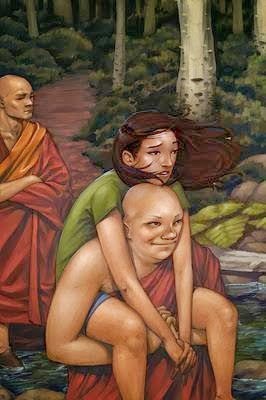In Japan there is an art form called Sumi Painting. Sumi painting uses just black ink and a brush. Black ink is black ink, but black ink is not black as a single colour. If you paint a pine tree with black ink, that one color creates many colors. Perhaps you have seen a sumi paintings; tiny boat, fisherman in the boat, ocean. And in the corner, just one tree; that's all. Can you imagine this? Just one tiny boat, and just one little tree, and no colours, just white. White in one color, but from white, space is created, and many colors. From this you can see the huge scale of the world; sunny days, cloudy days, oceans -- all this expressed in different ways. From sumi painting you can feel this, that is why in sumi painting black is not just black.
Another characteristic of sumi painting is that with sumi painting you have to listen to the rhythm of the universe, the rhythm of the world--the tree, the boat, the ocean. The ocean is white, but you have to have eyes to see, ears to listen to the rhythm of the ocean, the rhythm of the boat, the rhythm of the tree. This is very important. For instance, there is interesting poem composed by Ikkyu Zenji, a famous Zen master. It says:
And what is it, the heart?
It is the sound of pine breeze
There in the sumi painting.
According to Buddhism, mind is just like the sound of the pine breeze in the sumi painting. There, on the paper, is the pine tree, and the ocean, and the boat. And you can feel the breeze, and the sound of the breeze, from the painting.
In another poem a Zen master says:
The breeze in the sumi painting---
How cool it is!
Even oneness disappears
When culminating in not-two.
Two means the dualistic world. For instance, when you want to swim, there is the ocean and there is you. It is dualistic. "Culiminating in not two" means jump into the ocean. Ocean and you become one. That is the ultimate state of becoming one. In other words, oneness is not an idea of oneness. The oneness of the ocean and you is something active, something that leaves no trace of form. Activity is constantly moving from movement to movement. We do not realize it, but mind it always picking up activity right at the moment of activity. When you pick up activity, immediately immediately it is form or experience. But right in the midst of activity there is no form. All you have to do is just be there. This is oness.
Oneness is the rhythm of the sameness of ocean and you. And that time it is called "to swim." To swim is constantly to swim. If something is wrongly with the power of your body, you cannot swim. So your whole body and mind must be operating smoothly; that is "to swim." It is leaving no trace of my any form. That is why the Zen master says, "Even oneness disappears when culminating in not-two." That is the breezer in the sumi painting. It is not something dead. It is not something dead. It is something you have to realize. It is cool. "How cool it is" means you cannot explain, but you can feel how cool it is. that is most important. If you leave no trace of any form, experience becomes just like a breeze in the sumi painting.
In sumi painting, there is something painted by a brush, but even though you paint the pine tree on paper, that pine tree is not something painted. It must be something alive, something that is exactly the same as the pinetree living in nature. At that time, people are moved by the painting. When you really understand the pine tree, the pine tree becomes alive on the paper. You can feel the breeze moving in the pine tree. You can feel the sound of the breeze and how cool it is. You cannot explain it, but it is beautiful.
---------------------------------------------------------------------------------------
Source: RETURNING TO SILENCE: Zen Practice in Daily Life by Dainin Katagiri
----------------------------------------------------------------------------------------
----------------------------------------------------------------------------------------




















